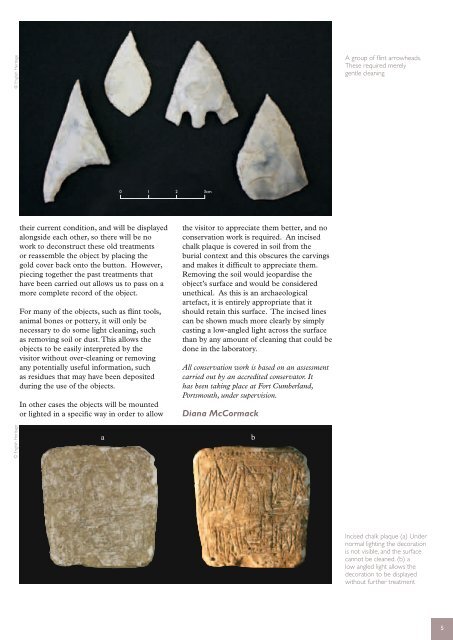Research News Issue 19: Spring 2013 | PDF - English Heritage
Research News Issue 19: Spring 2013 | PDF - English Heritage
Research News Issue 19: Spring 2013 | PDF - English Heritage
You also want an ePaper? Increase the reach of your titles
YUMPU automatically turns print PDFs into web optimized ePapers that Google loves.
© <strong>English</strong> <strong>Heritage</strong><br />
A group of flint arrowheads.<br />
These required merely<br />
gentle cleaning<br />
their current condition, and will be displayed<br />
alongside each other, so there will be no<br />
work to deconstruct these old treatments<br />
or reassemble the object by placing the<br />
gold cover back onto the button. However,<br />
piecing together the past treatments that<br />
have been carried out allows us to pass on a<br />
more complete record of the object.<br />
For many of the objects, such as flint tools,<br />
animal bones or pottery, it will only be<br />
necessary to do some light cleaning, such<br />
as removing soil or dust. This allows the<br />
objects to be easily interpreted by the<br />
visitor without over-cleaning or removing<br />
any potentially useful information, such<br />
as residues that may have been deposited<br />
during the use of the objects.<br />
In other cases the objects will be mounted<br />
or lighted in a specific way in order to allow<br />
the visitor to appreciate them better, and no<br />
conservation work is required. An incised<br />
chalk plaque is covered in soil from the<br />
burial context and this obscures the carvings<br />
and makes it difficult to appreciate them.<br />
Removing the soil would jeopardise the<br />
object’s surface and would be considered<br />
unethical. As this is an archaeological<br />
artefact, it is entirely appropriate that it<br />
should retain this surface. The incised lines<br />
can be shown much more clearly by simply<br />
casting a low-angled light across the surface<br />
than by any amount of cleaning that could be<br />
done in the laboratory.<br />
All conservation work is based on an assessment<br />
carried out by an accredited conservator. It<br />
has been taking place at Fort Cumberland,<br />
Portsmouth, under supervision.<br />
Diana McCormack<br />
© <strong>English</strong> <strong>Heritage</strong><br />
a<br />
b<br />
Incised chalk plaque (a) Under<br />
normal lighting the decoration<br />
is not visible, and the surface<br />
cannot be cleaned. (b) a<br />
low angled light allows the<br />
decoration to be displayed<br />
without further treatment<br />
5
















